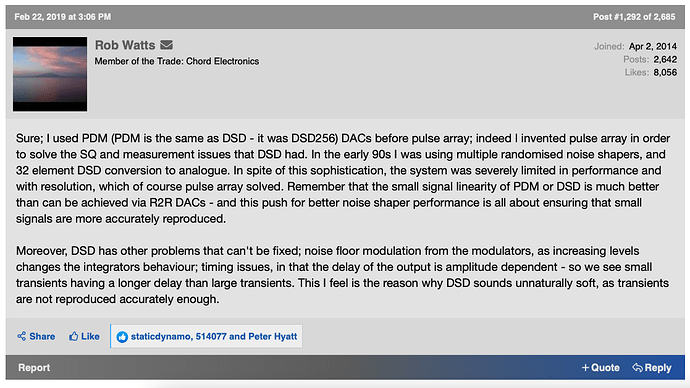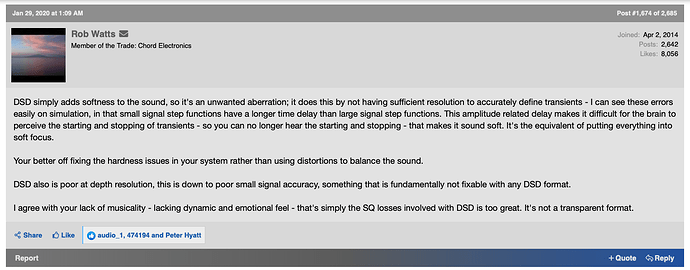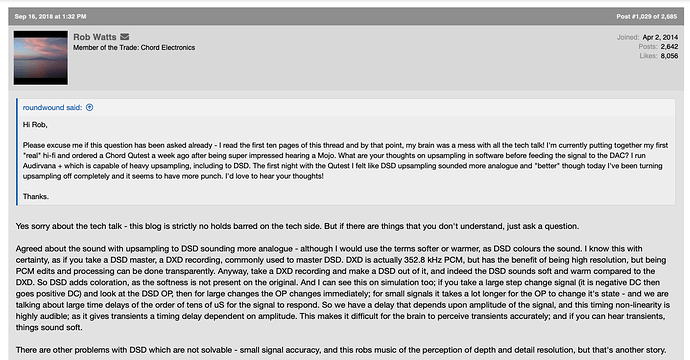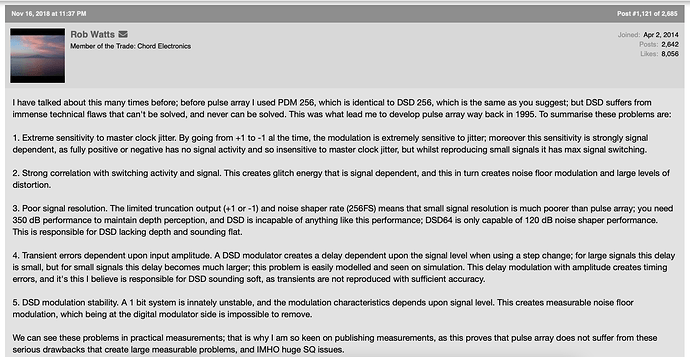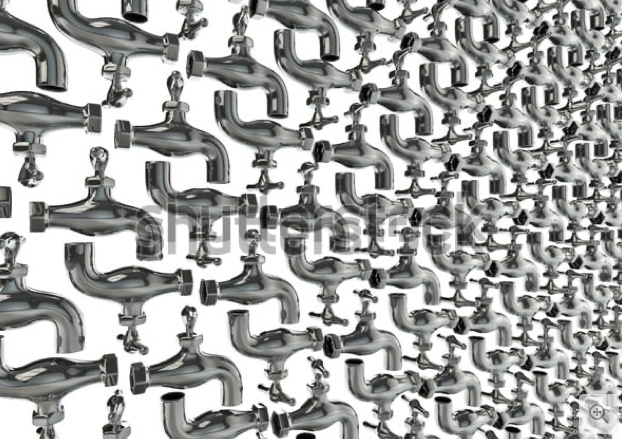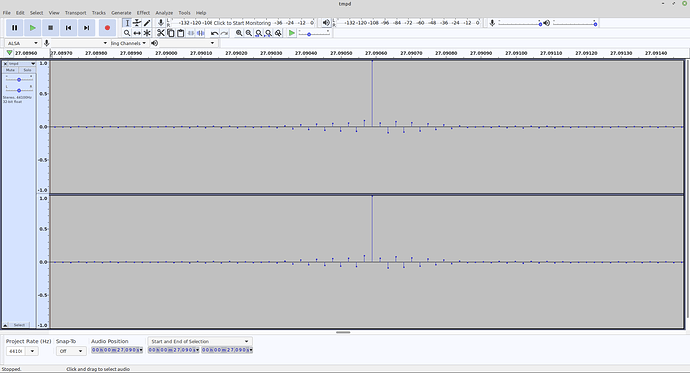‘DSD’ gets converted to ‘PCM’ during processing because DSD cannot be processed directly. You can’t mix or apply volume to a signal that has only two levels. PCM itself gets converted to floating point for processing even when it has 24 or 32 bits.
Wrong… I don’t know where you pull these.
All DAC chips and practically all FPGA implementations process PCM in fixed point integer format. Because implementing floating point is too complex and costly for such.
And you can process SDM in various ways. Let’s stop talking about DSD and other marketing terms that don’t exist in engineering space.
There is nothing that says that something gets converted into something. It doesn’t matter how many “levels” you have. When you add two 24-bit values, the result has 25-bits. And when you multiply two 24-bit values, the result has 48-bits.
Fair enough. Replace ‘floating’ with ‘fixed or floating’. It’s still a conversion. I wasn’t talking about DACs in particular, I was talking about DSP in general.
There’s a very specific difference between floating and fixed point. And you don’t need to convert anything for DSP. It is all up to your implementation. But you cannot generalize implementations.
Not sure I understand this part. Say you have integer samples (with at least 7 bits) and you want to apply a volume change of -3 dB. If input is 60, the output should be about 42.5. If you want to keep the format and output 42 or 43, you’ll introduce correlated quantization noise and your volume control will be really bad. The right thing to do would be to re-quantize with dither and possibly shaping, which means you’d have to use real numbers, floating or fixed. Isn’t that a conversion? It is internal, but you have to do it.
Yes, but you can apply dither using pure integer maths. And to be exact, -3 dB multiplication factor is 0.70795… So the output should be 42.477…
And then you can always think what you consider “conversion”. You also have “conversion” when you compress PCM to FLAC. Or “conversion” when you play PCM AIFF file on Intel or ARM architecture (since AIFF format uses big-endian values, while Intel and ARM are little-endian). Or you have “conversion” when you play 24-bit file to most USB audio interfaces since they use 32-bit sample format.
A lot of this discussion doesn’t relate to the enquiries I wanted to make of other users. Namely:
-
Do you perceive DSD (or, if you prefer, both SDM output from HQ Player and DSD recordings) as having a different attack, leading edge or transient dynamics from PCM ?
-
Do you have any theories, conjectures or explanations about why there is any such difference ?
I think it can depend how the DAC handles DSD.
Can you bypass the DAC’S (crappy?) modulator and how “clean” is the DSD to analogue conversion/output.
One of Jussi’s closest friends ![]() has been discussing this for years.
has been discussing this for years.
I know Jussi is tired of addressing these but may be interesting for others to read.
A selection of his greatest DSD hits:
thx for posting. excellent real knowledge, how refreshing.
Just to share subjective experiences:
I have an RME ADI-2 (AKM model) which can convert DSD256 to analogue , bypassing all internal DSP. So I can do ALL DSP in HQPlayer, upsampling all PCM content to DSD256 with super high quality modulator. I have this connected to an objectively transparent SMSL SP400 (THX AAA 888) headphone amp and headphones.
I also have a Chord Hugo2.
There is little difference to my ears between my my RME + DSD256 rig and my Hugo2 (just bit perfect playback of the same PCM music content with the Chord).
Both are high quality. And that’s even comparing 2 different headamp amps (SMSL vs Hugo2 built-in) powering the same headphones.
I would be interested to see if Rob could really pick out the ‘problems’ he mentions, if he didn’t know what was connected and playing to his favourite MrSpeakers Aeon headphones and everything was level matched etc.
I suspect he would have a really tough time.
But we’ll never know 
I can relate to Rob Watts comments above on DSD softness. That’s what I hear as well. I don’t even find it subtle. When I am concentrating I seem to be able to convince myself I like it but then in an unguarded moment or off-axis, there is something playing and I am immediately swapping cables around and switching things on and off and swapping HQP filters.
I have eventually settled on sync-L / ASDM7EC, subjectively because it seems to claw back as much of the PCM glare I am missing. The other issue is that realistically I can barely get to DSD64 with convolution in this combination without drop outs with a laptop i7. So what i am hearing may be a function of not being able to up sample enough.
So jury is out for me with DSD as well. I am toying with the idea of a more powerful desktop DSP server but I might just go back to the PCM I seem to prefer.
Can you share which DAC?
Would be nice if everyone sharing their experience could share this.
Otherwise it’s hard to think of an explanation.
For example, if someone says DSD sounds soft but then says they have a Chord Qutest , there’s a simple explanation. DSD is decimated (forgive me if I use the wrong technical term there, I have vague memory he used that word but may be wrong) for all of Rob’s DACs except Chord Dave.
Two DAC’s.
A Gustard x16 which I have even tried putting in NOS mode. Doesn’t sound good in NOS mode to my ears but that may be a function of not being able to up sample sufficiently. Does native DSD up to DSD256 although in practical terms I cannot up sample PCM to above DSD64 with both convolution and HQP filters on my core anyway. Also to put things in perspective I have exactly one DSD256 album and seven DSD128’s and a few dozen DSD64’s. The rest is PCM.
Also a Mark Levinson 5101. This does up to DSD128 but it is a network DAC with no USB input. So I don’t use it with HQP. It is also a DLNA DAC so with roon I use the LMS bridge. It has 7 inbuilt filters and I prefer the apodizing filter. Streaming DSD to the ML5101 over roon I hear the same DSD “softness”.
Both of these DACs feature an ESS chip.
Which means you cannot fully bypass their internal DSP (particularly modulator) with HQPlayer the way you can with my RME (AKM in DSD Direct Mode) or a Holo Audio or T+A DAC (and there’s others).
@andybob has mentioned in several posts he has a Holo DAC and still misses transient attack with DSD. There are many Holo models though. Maybe they do not all have an internal DSP bypass feature?
I’m tired because I’ve demonstrated with measurements his DSD claims to be false. And he has never demonstrated his claims to be true.
OTOH, I have also demonstrated his modulators suffering from lot of spurious and idle tones (Chord Mojo).
Of course with crappy modulator results are crappy, it all depends on your modulator design.
HQPlayer modulators have about 160 dB SNR at DSD64 rate. This exceeds 144 dB of 24-bit PCM.
And what comes to timing, here’s demonstration that the claims are false. Test signal is train of Dirac pulses at 44.1k, on left channel 0 dBFS level and on right channel -60 dBFS level. Then converted to DSD64 and back to 44.1/32 PCM, loaded to Audacity and levels of both channels normalized to 0 dBFS. You can see that both channels look exactly the same and peak is still on the same sample.
Note, I compare PCM and DSD on a DAC with real PCM and DSD conversion.
There is no point to compare with SDM DACs where PCM inputs result in DSP processing like oversampling and SDM conversion. Or likewise DSD inputs may involve conversion to low rate PCM (Chord).
Yes, DSD has much better attack and leading edge, with more weight. While PCM sounds flat, shallow and congested. This effect is smallest at 1.5M PCM, but still there. Like with DSD the drum sounds like a real “thump-thump” while on PCM it just sounds like “flap-flap”. With PCM, the body is missing.
So far, to me, ASDM7EC modulator gives the cleanest transients. I was kind of surprised how big difference it was over ASDM7, given how low in level the differences are. Listening to DSD256 recordings is also very nice. With DSD64 recordings the results clearly depend on the ADC used.
There are now at least two nice DSD256 ADC’s, Merging and RME.
Yes, insufficient reconstruction due to low digital filter oversampling rate. With PCM you can reach at most 1.5M. This still leaves images and thus incomplete reconstruction. Another reason are linearity errors. This is where listening experience and measurements correlate, when digital filter output rate is increased and linearity errors corrected with a noise-shaper and reduced bit-depth the adverse PCM effects are lessened.
When I run the DAC at DSD256 rate, I can run digital filters up to 256x instead of 32x (1.5M PCM) and the modulator ultimately solves linearity problems.
Mr. Bob has a great Holo Spring. All Springs and May have discrete ‘direct’ DSD to analogue conversion.
I respect his and everyones subjective impressions.
But maybe for @Rugby’s next zoom we livestream Mr. Bob trying to pick, PCM music upsampled to DSD256 vs PCM768kHz ![]()

I have a Holo Spring 1 (Level 2) and am seriously considering a May.
I’ve just realised, however, that my perception of DSD having a reduced transient attack is really a recollection of comparing them years ago on an original Auralic Vega, which is a SABRE DAC. The Spring has been set on NOS and fed DSD 512 or 256 almost universally since I got it.
As mentioned above, I find DSD 256 with the ASDM7EC modulator and ext2 filter to have very good transient response, but I haven’t compared it to lower DSD rates, different modulators or PCM. I’m really just comparing it to real world transients like handclaps.
Can someone explain (in layman terms) how analogue conversion is done using resistor ladder DACs if not by converting to multibit?
